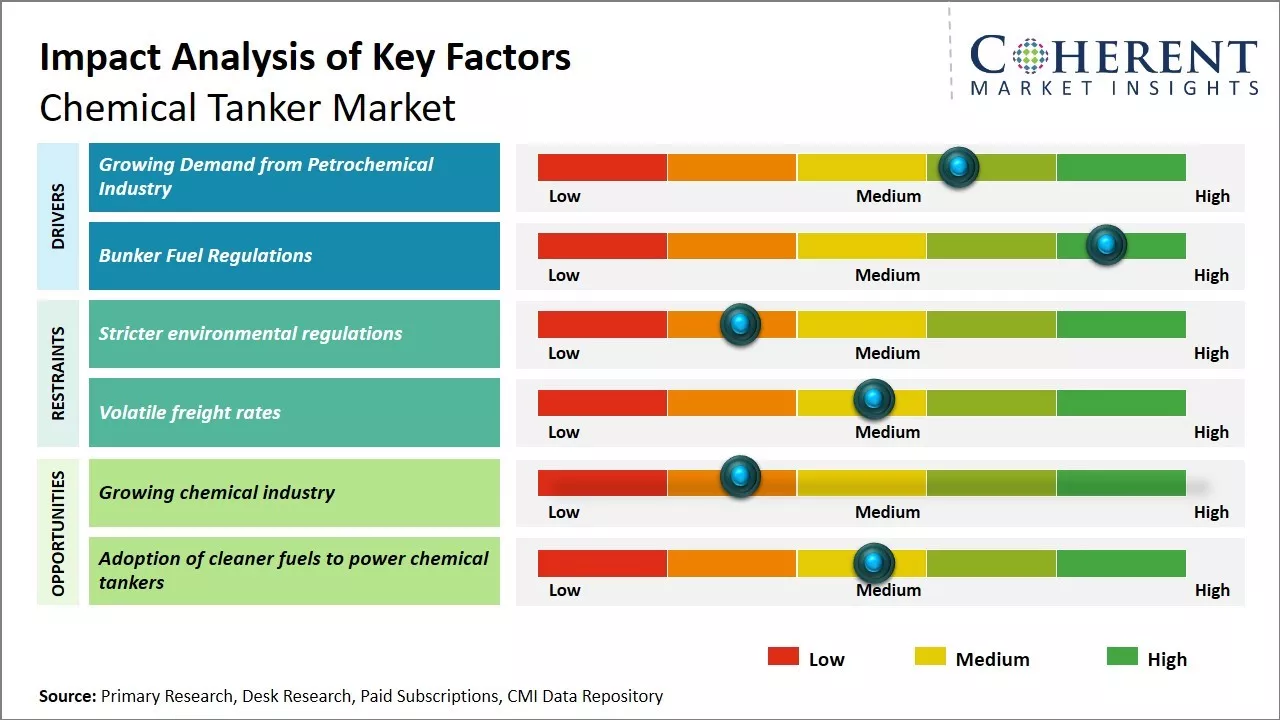Chemical Tanker Market Size and Trends
The chemical tanker market is estimated to be valued at USD 37.86 Bn in 2025 and is expected to reach USD 52.26 Bn by 2032, growing at a compound annual growth rate (CAGR) of 4.7% from 2025 to 2032.

To learn more about this report, Download Free Sample
Key Takeaways
- Based on Product Type, Organic Chemical segment is projected to account for 46.1% share of the global market in 2025, owing to growing demand in various industries such as pharmaceutical, food processing, and agriculture.
- Based on Fleet Type, IMO2 segment is expected to capture the 35.8% share of the market in 2025, due to optimal balance between transport efficient and cost effectiveness as compared with other fleet type.
- Based on Fleet Size Type, the Deep-Sea chemical tankers (10,000-50,000 DWT) segment is projected to command 37% share of the market in 2025, due to growing cross-border chemical trade volumes.
- Based on Region, North America is set to dominate the global market with a 47.8% share in 2025.
Market Overview
Inflation and rising energy demands are driving the greater seaborne trade of crude and petroleum products. The expansion of the global petrochemical industry has also increased the demand for the transport and trade of commodity and specialty chemicals via tankers.
The chemical tanker market trend has been positive over the past few years. As global petrochemical consumption increases steadily, chemical tankers continue experiencing high vessel utilization rates and freight rates.
Current Events and their Impact on the Chemical Tankers Market
|
Current Event |
Description and its Impact |
|
Red Sea Shipping Crisis and Maritime Security Tensions |
|
|
Global IMO Environmental Regulations and Decarbonization Mandates |
|
Uncover macros and micros vetted on 75+ parameters: Get instant access to report
End User Feedback and Unmet Needs in the Chemical Tankers Market
End User Feedback in the Chemical Tankers Market
End users in the chemical tankers market, including chemical producers, traders, and logistics managers, consistently emphasize the need for safety, reliability, and cargo integrity. They value vessels that can transport multiple segregated chemical parcels without risk of contamination, as well as precise temperature and pressure control to maintain product quality. Timely delivery and schedule adherence are also critical, as chemical cargoes are often time-sensitive or reactive.
Unmet Needs in the Chemical Tankers Market
Some unmet needs persist in the chemical tankers market. Users frequently cite a shortage of modern, fuel-efficient, and low-emission vessels, especially those compliant with upcoming environmental regulations. There is also a gap in tankers with advanced cleaning systems, which limits flexibility in switching between cargoes and increases downtime and cost. Inadequate infrastructure at certain ports—such as limited berthing capacity, outdated handling systems, or inconsistent safety protocols—further disrupts operations
Growing Demand from the Petrochemical Industry
The petrochemical industry has been experiencing significant growth over the past decade driven by the increasing consumption of plastics and chemicals globally. For instance, in August 2023, India's chemical and petrochemical (CPC) industry held a significant position in the world market, worth 178 USD Bn, and it is expected to grow to about 300 billion USD by 2025.
A large portion of petrochemical products are transported via chemical tankers as seaborne transportation is the most feasible option for their bulk transportation over long distances. As global petrochemical production continues to expand to meet the rising demand from end-use industries such as packaging, construction, and automobiles, it will invariably lead to higher volumes of petrochemical volumes being shipped internationally via tankers.
Several key petrochemical producers are investing heavily to expand and build new facilities across major markets. For instance, Saudi Aramco has ongoing projects to develop massive petrochemical complexes along its eastern coast to gain advantages from low feedstock prices and access to Asian markets. Similarly, plans are underway in the U.S. to build new crackers on the Gulf Coast enabled by abundant shale gas.
As more petrochemical capacities come online globally in the coming years to capitalize on emerging opportunities, it will support the growth of petrochemical seaborne trade volumes and positively impact the demand for chemical tankers.
Market Concentration and Competitive Landscape

To learn more about this report, Download Free Sample
Market Drivers
Bunker Fuel Regulations
Starting from January 2020, the International Maritime Organization has imposed lower global sulfur cap of 0.50% m/m on bunker fuel used across all commercial shipping fleets. This is aimed at significantly reducing vessel-related air pollution and compliance is mandatory for ship operators. To adhere to the new regulations without having to install expensive exhaust cleaning systems, ship owners largely opted to switch to low-sulfur fuels from high-sulfur fuel oil or marine gas oil.
However, low-sulfur fuel is more expensive compared to high-sulfur fuel and shipping companies have faced considerable increase in their operating costs which was already a tight margin business. Faced with rising costs, shipping lines are trying to pass on higher freight rates to cargo owners and are rationalizing their fleets to bigger tankers that can achieve economies of scale and efficiency.
This is inducing replacement demand for new buildings and pushing older tonnage to scrapyards prematurely. Ensuing fleet renewal and capacity replacement is generating fresh demand for chemical tankers in the market.
Chemical Tanker Market Insights, By Product Type: Growth in Manufacturing Industries is driving the Organic Chemicals Segment
In terms of product type, organic chemicals contribute 46.1% share of the market owing to rapid growth in industries where organic chemicals are extensively used such as pharmaceutical, agriculture, and food processing among others. Organic chemicals find widespread application as raw materials, intermediates and final products in these core industries.
Furthermore, rapid industrialization along with infrastructure development activities underway across developing regions provide an impetus to manufacturing industries, further necessitating organic chemicals as intermediate goods.
In May 2025, Argus launched a new freight service providing global pricing and market insights for biofuels, feedstocks, and related chemicals. As demand for biofuels grows to meet net zero goals and diversify energy sources, the market now spans products like SAF, HVO, and biodiesel, along with key feedstocks such as used cooking oil and tallow.
Chemical Tanker Market Insights, By Fleet Type: IMO 2 Segment Dominates Due to Cost Benefits over Alternatives
In terms of fleet type, IMO 2 contributes 35.8% share of the market owing to its optimal balance between transportation efficiency and cost effectiveness over other fleet types. IMO 2 tankers, having a DWT capacity between 5,000 to 80,000, offer economies of scale allowing operators to transport larger volumes of chemicals at relatively lower unit transportation cost compared to smaller IMO 1 tankers.
At the same time, IMO 2 tankers are more maneuverable and accommodate at more ports when compared to very large IMO 3 tankers which are generally deployed for long-haul trades. Their multi-purpose utility makes IMO 2 tankers highly preferable for short-sea, coastal and regional chemical transportation where frequent port calls are involved.
Furthermore, IMO 2 vessels offer savings on crewing and maintenance costs due to larger crew accommodation and multi-cargo handling capabilities.
For instance, in March 2024, Times Shipbuilding Co., Ltd announced the launch of one 50,000 DWT Product Oil/Chemical Tanker (IMO Type 2) with Hull No.0405037.
Chemical Tankers Market Insights, By Fleet Size Type: Deep Sea Tankers are Fulfilling the Expanding Global Trade Demand
In terms of fleet size type, deep sea chemical tankers (10,000- 50,000 DWT) contribute 37% share of the market owing to growing cross-border chemical trade volumes. Post containerization, chemical transportation demand has significantly shifted from traditional bulk trades to several hub-and-spoke long-haul routes connecting major producer and consumer economies globally.
Deep sea tankers are specifically designed for carrying chemicals across oceans while meeting stringent safety, environmental and material compatibility standards. Their large cargo capacities allow operators to achieve substantial economies of scale through consolidation of regional cargoes.
As chemical production and consumption centers in emerging countries continue to expand rapidly, deep sea vessels are indispensable in facilitating efficient exchange of feedstock and finished products on the world stage. Their critical role in lubricating globalization drives sustained investment into deep sea chemical tankers, safeguarding this segment's prominent position.
Regional Insights

To learn more about this report, Download Free Sample
North America Chemical Tanker Market Analysis & Trends
The North America region has dominated the global chemical tanker market for decades with a market share 47.8%. With a well-established petrochemical industry centered on the Gulf Coast, North America requires significant tanker capacity to transport chemicals both domestically and internationally.
Major hubs like Houston and New Orleans see huge quantities of product shipped routinely on tankers of all sizes. The size and scale of petrochemical facilities in the region have given North American operators tremendous bargaining power. Tanker companies with dedicated vessels serving regional routes are able to guarantee capacity and optimize fleet deployment.
This reliability and consistency have allowed North American producers to run facilities at maximum rates knowing transportation will not constrain output. Pricing in many trades is influenced considerably by these dynamics.
For instance, according to the U.S. Energy Information Association, the U.S. exported around 20.9 billion cubic feet per day (Bcf/d) of natural gas in 2023.
Asia Pacific Chemical Tanker Market Analysis & Trends
Asia Pacific trades feature more diverse routings and more complex logistical requirements compared to North America. Tanker operators have rushed to add tonnage in order to capitalize on the market opportunities. Fleet development in the region has evolved year-by-year to keep pace with shifting trade lanes as production capacity shifts between countries.
Although intra-Asia Pacific transport has grown the most, longer-distance exports to markets like North America and Europe have also increased steadily. As a result, chemical tankers engaged in Asia Pacific are now exposed to a wider variety of commercial and operational conditions than ever before.
For instance, in November 2023, Stolt Tankers introduced its new tanker pool within its Stolt NYK Asia Pacific Services. This deal sees two Eneos Ocean-owned 12,000-dwt ships join the SNAPS chemical tanker pool during Q4 2023.
Chemical Tankers Market Outlook Country-Wise
China Chemical Tankers Market Trends
China chemical tanker shipping market dominance is attributed by the combination of factors, including advanced chemical industry, growing export requirements to and from China, superior infrastructure facilities, supportive government policies, advanced technologies, and the burgeoning prospects of specialty chemicals. These factors, along with general economic developments, are the primary drivers for the growth of the chemical tanker shipping business in China.
For instance, in October 2024, China's Jiangxi Xinjiang Shipbuilding Heavy Industry launched a new chemical tanker ordered by local owner Zhoushan Yongcheng Shipping.
Japan Chemical Tankers Market Trends
The Japan chemical tankers market is experiencing notable shifts driven by fleet modernization, environmental regulations, and evolving global trade dynamics. Japanese shipping companies are investing in new, fuel-efficient stainless-steel parcel tankers, many of which are designed to meet stringent emissions standards and are capable of running on alternative fuels like methanol or LNG.
For instance, in April 2024, Japanese shipbuilder Fukuoka Shipbuilding introduced the third in a series of four stainless steel chemical tankers powered by liquefied natural gas (LNG) for US-based shipowner Fairfield Chemical Carriers.
Market Report Scope
Chemical Tanker Market Report Coverage
| Report Coverage | Details | ||
|---|---|---|---|
| Base Year: | 2024 | Market Size in 2025: | USD 37.86 Bn |
| Historical Data for: | 2020 To 2024 | Forecast Period: | 2025 To 2032 |
| Forecast Period 2025 to 2032 CAGR: | 4.7% | 2032 Value Projection: | USD 52.26 Bn |
| Geographies covered: |
|
||
| Segments covered: |
|
||
| Companies covered: |
JO Tankers, IINO KAIUN KAISHA Ltd., Eitzen Chemical, Tokyo Marine Asia Pte Ltd., Berlian Laju Tanker, Nordic Tankers, Seatrans chemical tankers, Navig8 Chemicals, Stolt-Nielsen Ltd, and Odfjell |
||
| Growth Drivers: |
|
||
| Restraints & Challenges: |
|
||
Uncover macros and micros vetted on 75+ parameters: Get instant access to report
Market Opportunities: Growing chemical industry
The demand for tankers is correlated with the larger chemicals industry. As population and standards of living grow across Asia Pacific and elsewhere increase, the demand for petrochemicals is expected to rise.
Analyst Opinion (Expert Opinion)
- The chemical tanker market is projected to witness steady growth in upcoming decade. The demand for chemicals and petrochemicals transportation across regions will be a key driver of growth. Global trade in chemical and petrochemical products is increasingly steadily and so is the dependence on sea-based transportation. Higher trade volumes will directly translate to more demand for chemical tankers
Chemical Tanker Industry News
- In January 2025, Hercules Tanker Management announced the arrival of its IMP Type 2 chemical tanker Hercules Galaxy to its fleet.
- In July 2025, Stainless Tankers announced that the company has entered into an agreement for sale of the 2008-buily J19 stainless steel chemical.
- In March 2024, Mitsui O.S.K. Lines, Ltd, announced that the company wholly owned subsidiary, chemical tanker operator MIL Chemical Tankers Pte, Ltd has completed its acquisition of all shares of Fairfield Chemical Carriers Pte, Ltd.
Market Segmentation
- Product Type Insights (Revenue, USD Bn, 2020 - 2032)
- Organic Chemicals
- Inorganic Chemicals
- Vegetable Oils and Fats
- Fleet Type Insights (Revenue, USD Bn, 2020 - 2032)
- IMO 1
- IMO 2
- IMO 3
- Please Size Type Insights (Revenue, USD Bn, 2020 - 2032)
- Inland Chemical Tankers (1001-5000 DWT)
- Coastal Chemical Tankers (5001-10000 DWT)
- Deep Sea Chemical Tankers (10,000- 50,000 DWT)
- Regional Insights (Revenue, USD Bn, 2020 - 2032)
- North America
- U.S.
- Canada
- Latin America
- Brazil
- Argentina
- Mexico
- Rest of Latin America
- Europe
- Germany
- U.K.
- Spain
- France
- Italy
- Russia
- Rest of Europe
- Asia Pacific
- China
- India
- Japan
- Australia
- South Korea
- ASEAN
- Rest of Asia Pacific
- Middle East & Africa
- GCC Countries
- Israel
- Rest of Middle East & Africa
- Key Players Insights
- JO Tankers
- IINO KAIUN KAISHA Ltd.
- Eitzen Chemical
- Tokyo Marine Asia Pte Ltd.
- Berlian Laju Tanker
- Nordic Tankers
- Seatrans chemical tankers
- Navig8 Chemicals
- Stolt-Nielsen Ltd
- Odfjell
Sources
Primary Research Interviews
- Chemical tanker fleet operators and shipping companies
- Port terminal operators and chemical storage facility managers
- Chemical manufacturers and petrochemical companies
- Maritime logistics and freight forwarding companies
- Others
Databases
- Lloyd's List Intelligence Maritime Database
- IHS Markit Maritime & Trade Database
- Clarksons Research Services Database
- TradeWinds Maritime Database
- Others
Magazines
- Chemical Engineering Magazine
- Maritime Reporter and Engineering News
- Tanker Operator Magazine
- Chemical Week Magazine
- Marine Log Magazine
- Others
Journals
- Journal of Maritime Economics and Logistics
- Transportation Research Part E: Logistics and Transportation Review
- Maritime Policy & Management Journal
- Others
Newspapers
- TradeWinds (Maritime Industry Newspaper)
- Lloyd's List (Maritime Intelligence)
- The Maritime Executive
- Seatrade Maritime News
- Marine Link News
- Others
Associations
- International Association of Independent Tanker Owners (INTERTANKO)
- International Maritime Organization (IMO)
- Society of International Gas Tanker and Terminal Operators (SIGTTO)
- Chemical Distribution Institute (CDI)
- International Parcel Tankers Association (IPTA)
- Others
Public Domain Sources:
- International Energy Agency (IEA) Publications
- United Nations Conference on Trade and Development (UNCTAD) Reports
- International Chamber of Shipping (ICS) Publications
- Maritime and Port Authority Reports
- Government Maritime Department Publications
- Others
Proprietary Elements
- CMI Data Analytics Tool
- Proprietary CMI Existing Repository of information for last 8 years
*Definition: The chemical tanker market involves the sea transportation of chemicals and chemical products in dedicated and specialized tonnage vessels known as chemical tankers. Chemical tankers are used to carry bulk liquid chemicals in separate cargo tanks or compartments. They are specially designed and fitted with specific equipment to load, transport, and discharge a wide range of liquid chemicals and chemical products safely between manufacturers or production facilities and end users globally.
Share
Share
About Author
Yash Doshi is a Senior Management Consultant. He has 12+ years of experience in conducting research and handling consulting projects across verticals in APAC, EMEA, and the Americas.
He brings strong acumen in helping chemical companies navigate complex challenges and identify growth opportunities. He has deep expertise across the chemicals value chain, including commodity, specialty and fine chemicals, plastics and polymers, and petrochemicals. Yash is a sought-after speaker at industry conferences and contributes to various publications on topics related commodity, specialty and fine chemicals, plastics and polymers, and petrochemicals.
Missing comfort of reading report in your local language? Find your preferred language :
Transform your Strategy with Exclusive Trending Reports :
Frequently Asked Questions
EXISTING CLIENTELE
Joining thousands of companies around the world committed to making the Excellent Business Solutions.
View All Our Clients

